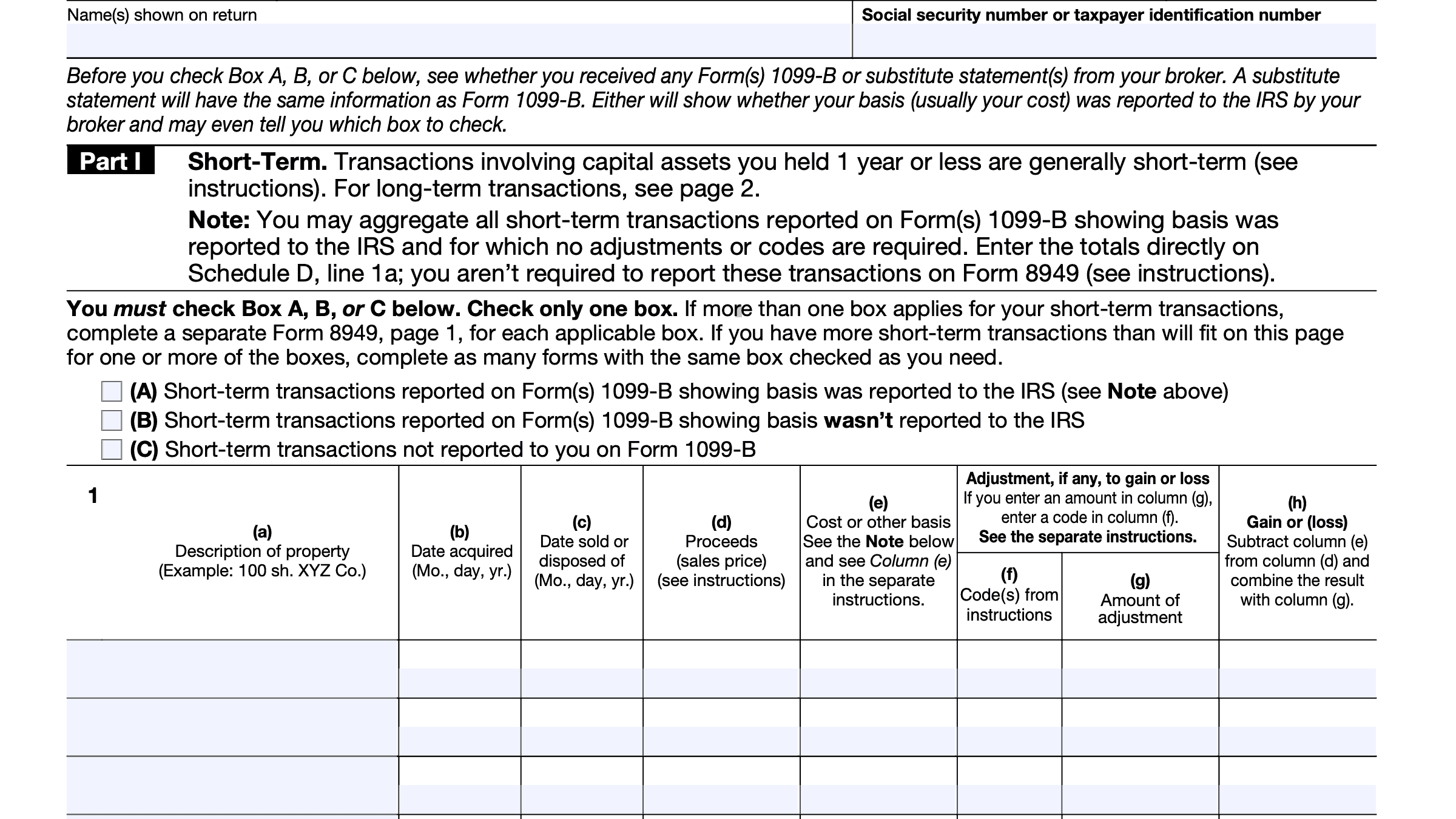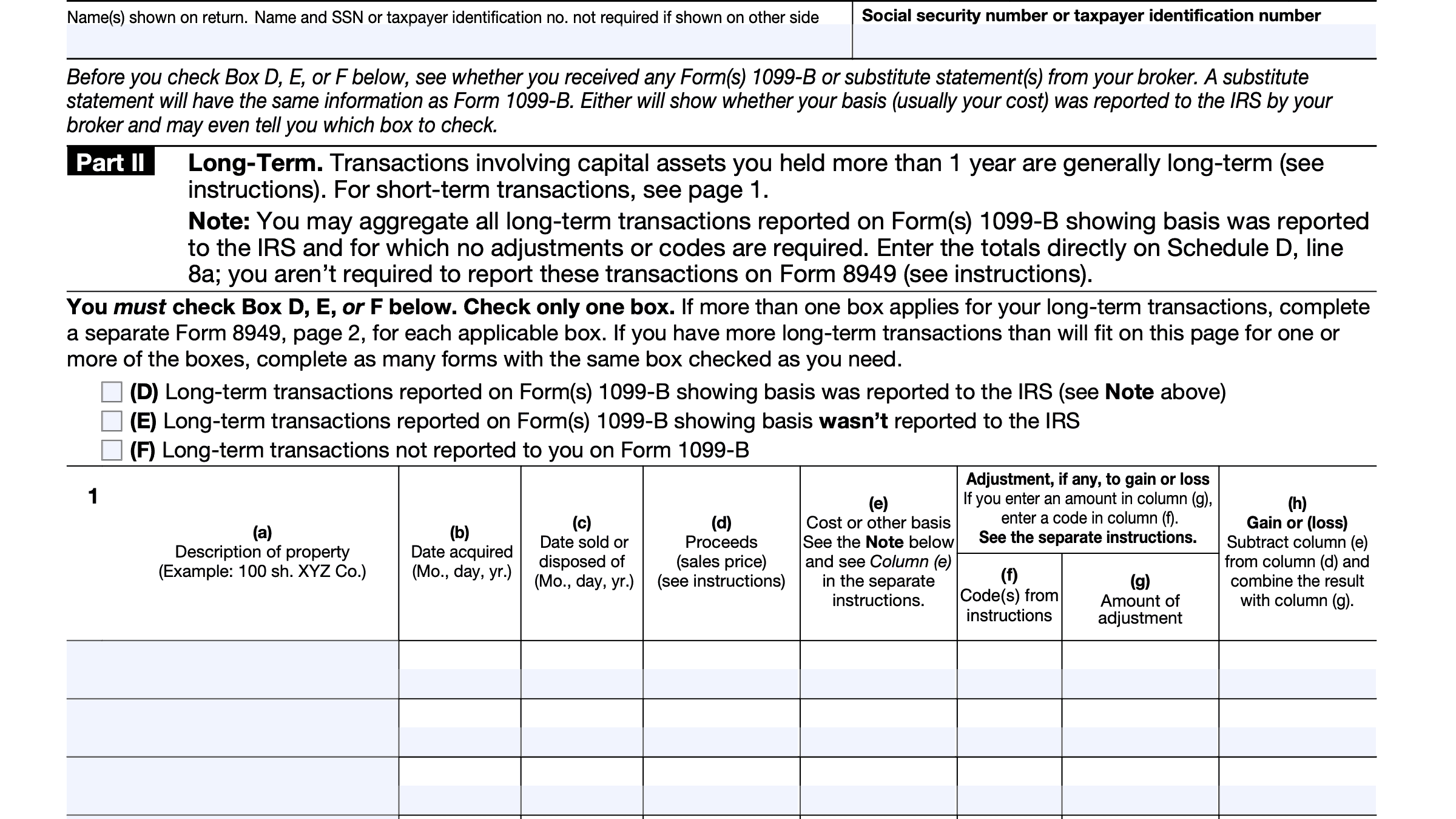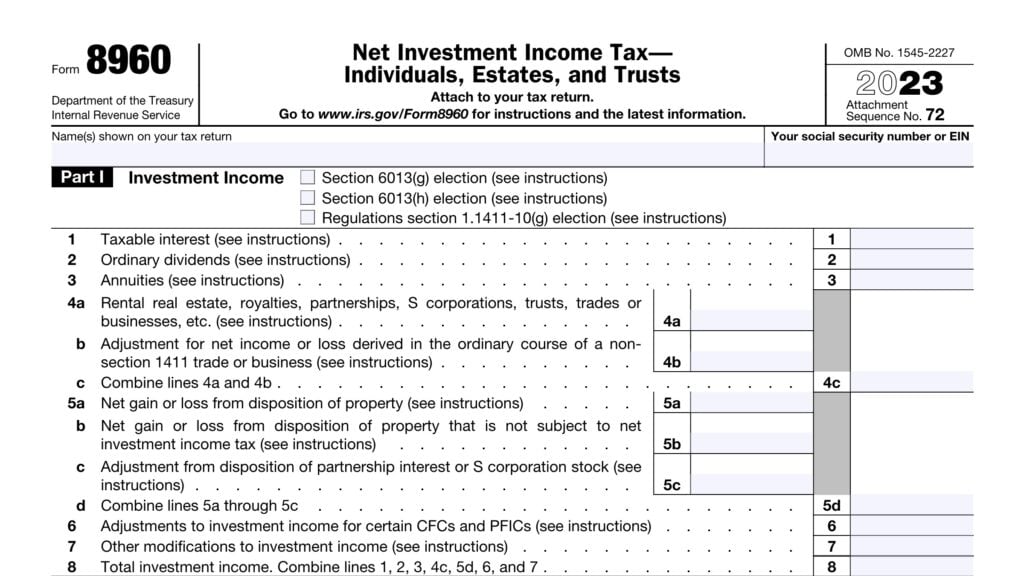IRS Form 8949 Instructions
If you have sold or disposed of investments in the past year, you may need to report those transactions on your tax return. More importantly, by filing IRS Form 8949 with your income tax return, you can reconcile the transactions as your broker or financial institution reported them to you and the Internal Revenue Service.
In this article, we’ll cover everything you need to know about IRS Form 8949. Let’s begin by walking through this tax form, step by step.
Table of contents
How do I complete IRS Form 8949?
There are two parts to this form:
- Part I: Short term transactions
- Part II: Long term transactions
Let’s start with Part I.
Part I: Short-term transactions
In Part I of Form 8949, you will list all short-term transactions that occurred during the tax year. Typically, short-term transactions are transactions that involve capital assets which you’ve held for one year or less.
At the top of the form, enter your name and Social Security number. If you do not have a Social Security number, enter your individual taxpayer identification number (ITIN). If you’re filing on behalf of a corporation or other entity, you may need to enter an employer identification number (EIN).
Box A, Box B, or Box C?
At the top of Part I, you’ll notice boxes marked A, B, and C. You will need to check exactly one of these boxes, depending on the type of short-term transaction you are reporting:
- Box A: Check Box A to report transactions where the transaction and basis was reported to you and the Internal Revenue Service on Form(s) 1099-B.
- Box B: Check Box B to report transactions where the transaction was reported to you and the IRS, but the basis of the asset was not.
- Box C: Check Box C to report transactions where the transaction was not reported to you at all on Form 1099-B
For taxpayers who have transactions in more than one category, you will have to file a separate Form 8949 for each type of transaction.
For example, John Smith is reporting 3 short-term transactions reported to him by his broker on Form 1099-B. Two transactions have the correct basis, while the third transaction is missing its cost basis. John would report the two transactions with correct basis on one Form 8949 with Box (A) checked, and the third transaction on a separate form with Box (C) selected.
Also, for married couples, you may have to complete a separate Form 8949 for each spouse.

Line 1
In Line 1, you should record each transaction separately, unless you can aggregate transactions or you meet one of the exception criteria, listed further in the article. Otherwise, you’ll need to complete columns (a) through (h) for each transaction.
Column (a): Description of property
In column (a), include a brief description of the property disposed of. For stocks or mutual funds, you should include the number of shares. You may use ticker symbols or symbols as long as they match the descriptions shown on your Form 1099-B or 1099-S (substitute statement).
When listing digital assets, you should include the full name or an abbreviated symbol of the digital asset, and the exact number of units sold or disposed of. If possible, include the sale transaction number.
Column (b): Date acquired
Enter the date that you acquired the property. For stocks, bonds, or mutual funds, this is the same as the trade date. For short sales, this would be the date that you acquired the property
On Forms 1099-B, refer to Box 1b to determine the date of acquisition.
For inherited property, you’ll enter this in Part II, as inherited property generally is subject to preferred capital gains treatment at long-term rates.
If you acquired stock over various dates, such as in a dollar cost averaging strategy, you may enter ‘VARIOUS’ in Column (b). However, you must still report short-term gains and losses in Part I, and long-term gains and losses in Part II.
Column (c): Date sold or disposed of
In Column (c), enter the date that you sold or disposed of the property. For stocks, bonds, and other securities traded on investment exchanges, this will be the trade date.
If you received a Form 1099-B, refer to Box 1c to determine the date of sale or disposition.
Column (d): Proceeds
Column (d) contains the sales price, or proceeds, of the sales transaction. How you report this depends on whether you received a Form 1099-B or Form 1099-S.
If you received a brokerage statement:
Enter the proceeds shown on the form or statement that you received. If there are selling expenses or option premiums not reflected on the statement, then you may need to adjust either the proceeds or the basis by entering ‘E’ in Column (f), then the necessary adjustment in Column (g).
If you did not receive a brokerage statement:
To report a transaction for which you did not receive a brokerage statement, then enter the net proceeds for the transaction. The net proceeds are gross proceeds minus transaction costs, such as fees, commissions, or taxes.
If you sold a call option, and it was exercised, then you will need to adjust the sales price of the sold property for any option premiums. Refer to the instructions for Schedule D for detailed instructions.
Column (e): Cost or other basis
The cost basis of any property that you purchase is usually the cost. This includes the purchase price as well as any transaction costs, such as fees or commissions.
You may not be able to use the actual cost in the following situations:
- Inheriting property
- Receiving property as a gift
- Receipt of property in a tax-free exchange, involuntary conversion, or in connection with a wash sale
The basis for inherited property is generally the property’s fair market value on the date of death. For property that you received as a gift, the cost basis is usually the donor’s cost basis.
For more detailed information on how to determine the cost basis of an asset, please refer to the IRS instructions.
Column (f): Adjustment code from IRS Form instructions
To explain adjustments to gains or losses in column (g), you must enter one or more adjustment codes, as outlined in the form instructions. If more than one code applies, enter all applicable codes in alphabetical order, but do not separate them by a space or comma.
Below is a list of specific situations and their corresponding code:
If you received Form 1099-B or a substitute, and the basis in Box 1e is incorrect
Enter code B in column (f) and do one of the following:
If this transaction is reported on a Part I with box B checked, or on Part II with box E checked, enter the correct basis in column (e), then enter ‘0’ in column (g).
If you reported this transaction on a Part I with box A checked, or on Part II with box D checked, enter the basis shown on Form 1099-B or its substitute in column (e). Enter an adjustment in column (g). To learn how to make this adjustment, you’ll need to see the worksheet for basis adjustments in column (g), below.

If you received a Form 1099-B or a substitute, and the type of gain (or loss) in box 2 is incorrect
Enter code T in column (f) then report the transaction on the correct part of Form 8949. Enter ‘0’ in column (g) if there are no adjustments required.
If you received a Form 1099-B or a substitute as a nominee for the property’s actual owner
Enter code N in column (f) then report the transaction on Form 8949 as if you were the actual owner. However, you should also enter any gains as a negative adjustment (using parentheses), or any losses as a positive adjustment in column (g).
After the adjustment, the amount in column (h) should equal zero. However, if you received capital gains distributions as a nominee, you may need to report them on IRS Schedule D.
If you sold or exchanged your main home at a gain, must report the sale or exchange in Part II, and you can exclude some or all of the gain
Enter code H in column (f) then report the sale or exchange as if you were not taking the Section 121 exclusion. Then, enter the amount of the excluded gain as a negative number in column (g).
For example, you bought your primary residence in 2015 for $100,000. In 2022, you sold your primary home in 2022 for $450,000 (after adjustments), realizing a $350,000 capital gain. As a single homeowner, you meet the criteria to exclude up to $250,000 of capital gain from your income. You would report as follows:
- Column (d): $450,000
- Column (e): $100,000
- Column (f): T
- Column (g): ($250,000)
- Column (h): $100,000
If you received a Form 1099-B or a substitute that shows accrued market discount in Box 1f
Enter code D in column (f) then use the worksheet for accrued market discount adjustment in Column (g), with the following exceptions:
- If you received a partial payment of principal on a bond, do not use the worksheet. Enter the smaller of the following in column (g):
- Accrued market discount
- Your proceeds
- If you choose to include market discount in income, enter ‘0’ in column (g). then follow the instructions for code B, above.

If you sold or exchanged QSB stock and can exclude part of the gain
Enter code Q in column (f) then report the sale or exchange as if you were not taking the exclusion, then enter the amount of the exclusion as a negative number in column (g). If this transaction is reported as an installment sale, you may need to refer to the Schedule D instructions for more detail.
If you can exclude part or all of the gain under rules outlined in Schedule D instructions for DC Zone assets or qualified community assets
Enter code X in column (f) then report the sale or exchange as if you were not taking the exclusion, then enter the amount of the exclusion as a negative number in column (g).
If you elect to postpone all or part of your gain under rules outlined in Schedule D instructions
Enter code R in column (f) then report the sale or exchange as if you were not taking the exclusion, then enter the amount of the postponed gain as a negative number in column (g).
If you have a nondeductible loss from a wash sale
Enter code W in column (f) then report the amount of the nondeductible loss as a positive number in column (g). See the Schedule D instructions or IRS Publication 550 for more details about wash sales.
If you received a Form 1099-B and the amount of nondeductible wash sale loss is incorrect, post the correct amount of the nondeductible loss as a positive number in column (g). If the amount of the loss is less than the amount shown on the statement, attach a separate statement explaining the difference.
Enter ‘0’ in column (g) if no part of the loss is a nondeductible loss from a wash sale.
If you have a nondeductible loss other than a loss indicated by code W
Enter code L in column (f) then report the amount of the nondeductible loss as a positive number in column (g).
If you received a Form 1099-B or substitute for a transaction and there are selling expenses or option premiums not reflected on the form, or a statement by an adjustment to the proceeds or basis shown
Enter code E in column (f) then enter in column (d) the proceeds shown on the form or statement.
Enter in column (e) any cost or other basis shown on the statement.
In column (g), enter any selling expenses or option premiums paid as a negative number. Enter any option premiums that you received as a positive number.
If you had a loss from the sale, exchange or worthlessness of small business stock (under IRC Section 1244), and the total loss is more than the maximum amount that can be treated as an ordinary loss
Enter code S in column (f) then refer to the Small Business stock section of the Schedule D instructions.
If you disposed of collectibles
Enter code C in column (f) then enter ‘0’ in column (g). Report the disposition as you would any sale or exchange.
If you report multiple transactions on a single row as outlined under one of the exceptions
Enter code M in column (f) then refer to the exceptions section of the form instructions. Enter ‘0’ in column (g) unless another code requires that you make another adjustment.
If you have an adjustment not otherwise explained
Enter code O in column (f) then enter the appropriate amount in column (g).
If you are electing to postpone part or all of your gain under Schedule D instructions for QOFs
Enter code Z in column (f) then see the form instructions on reporting an election to defer tax on eligible gains invested in a QOF.
If you are reporting your gain from a QOF that you previously deferred
Enter code Y in column (f) then refer to the form instructions on reporting a gain previously deferred in a QOF.
If no other statements apply
Leave column (f) blank.
Column (g): Amount of adjustment
In this column, enter any required adjustments to gain or loss. Enter negative adjustments in parentheses.
If you entered more than one code in column (f), enter the net adjustment in this column.
Column (h): Gain or loss
Calculate the gain or loss for each row.
First, subtract the cost basis figure in column (e) from the proceeds in column (d). From there, add or subtract any adjustments from column (g).
Enter the result in column (h) as the resultant gain or loss. Enter negative numbers in parentheses.
Line 2
In Line 2, you will enter the totals from the amounts in columns (d), (e), (g), and (h), above. Enter each total here and include these numbers on Schedule D as follows:
- If Box A is checked, enter total in Line 1b on Schedule D
- If Box B is checked, enter total in Line 2 on Schedule D
- If Box C is checked, enter total in Line 3 on Schedule D

Part II: Long-term transactions
Box D, Box E, or Box F?
At the top of Part II, you’ll notice boxes marked D, E, and F, for reporting long-term transactions, similar to Part I.
You will need to check exactly one of these boxes for the type of long-term transaction you are reporting:
- Box D: Check Box D to report transactions where the transaction and basis was reported to you and the Internal Revenue Service on Form(s) 1099-B.
- Box E: Check Box E to report transactions where the transaction was reported to you and the IRS, but the basis of the asset was not.
- Box F: Check Box F to report transactions where the transaction was not reported to you at all on Form 1099-B

Line 1
For Part II, you will follow identical instructions as in Line 1 for each transaction meeting the criteria for long-term gains (or losses) treatment.
Long term capital gains
You should treat the following types of transactions as long-term capital gains:
- Sale of capital assets held for more than 1 year
- Often referred to as one year, one day rule
- Holding period for long term treatment on the sale of race horses is 2 years
- Sale of inherited property, regardless of holding period
- Capital gain distributions from mutual funds.
- Always report capital gain distributions as long term regardless of how long you’ve held the mutual fund itself
- Reported on IRS Schedule D
Line 2
In Line 2, you will enter the totals from the amounts in columns (d), (e), (g), and (h), above. Enter each total here and include these numbers on Schedule D as follows:
- If Box D is checked, enter total in Line 8b on Schedule D
- If Box E is checked, enter total in Line 9 on Schedule D
- If Box F is checked, enter total in Line 10 on Schedule D

Video walkthrough
Watch this instructional video to learn more about reporting capital asset transactions on IRS Form 8949.
Frequently asked questions
Taxpayers use Form 8949 to report sales and exchanges of capital assets. Form 8949 allows you and the IRS to reconcile amounts reported to you and the IRS on brokerage statements such as Forms 1099-B or 1099-S (substitute statements).
Long term capital gains have a holding period of more than one year between acquiring and sale of an asset. Conversely, short term gains and losses have a holding period of one year or less. Long term capital gains are treated more favorably than short term gains, which are treated as ordinary income.
You may still need to report the transactions on Form 8949, depending on your situation. You should check to see if there is an appropriate code for column (f) to explain any adjustments you enter into column (g).
A qualified opportunity fund, or QOF, is an economically distressed community certified by the Internal Revenue Service. Investments in QOFs may be eligible for preferential tax treatment to create economic development opportunities in communities that might not otherwise receive capital investments.
Where can I find IRS Form 8949?
You may find copies of Form 8949 on the IRS website. For your convenience, we’ve included the most current version in this article.
Related tax articles
This tax form is one of the fillable tax forms provided by the Internal Revenue Service, to help taxpayers reduce their tax preparation costs. To see more forms like this, visit our free fillable tax forms page, where you’ll also find articles like this.
Unlike the IRS, our articles contain step by step instructions for each tax form, as well as video walkthroughs. You can also check out all of our videos by subscribing to our YouTube channel!



